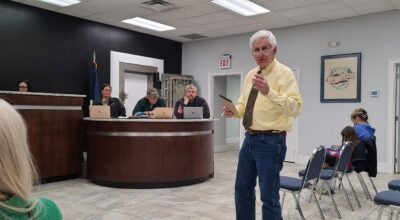KSP warns motorists of increased deer activity
Published 8:54 am Thursday, October 27, 2016
KENTUCKY STATE POLICE
News release
FRANKFORT, Ky. (Oct. 26, 2016) – With the changing of fall leaves comes the migration of wildlife, particularly deer. The Kentucky State Police is urging all motorists to be aware of the increased dangers posed by deer wandering onto roadways this fall.
“Drivers should be engaged, alert and on the lookout for deer this time of year. Deer mating season leads to higher roaming activity all across the Commonwealth, which leads to more car-deer crashes,” says KSP Lt. Michael Webb.
In 2015, Kentucky recorded 3,283 vehicle-deer collisions, an increase of 175 crashes compared to 2014 statistics. Three people were killed and 163 injured. Data indicates that the highest percentage of deer crashes occur between the hours of 5 p.m. and 7 p.m. in Kentucky.
“A collision with a deer can cause extensive vehicle damage such as a crushed front end or punctured radiator to severe hood, windshield and roof damage,” says Webb. “The human costs can be devastating as well.”
During the past five years, Boone County led the state in deer collisions with an average of 151 per year. Jefferson County averaged 98 crashes followed by Hopkins and Christian counties with 93.
To avoid becoming a statistic, KSP offers the following defensive driving tips for motorists to reduce their chances of hitting a deer:
Be extra cautious in the early morning and evening hours. Deer are most active during these low-light periods when motorists see worst and reaction time is slow.
Stay alert when driving through a known deer-crossing zone. If you see one deer, look for more. They often travel in herds.
Drive at a moderate speed, especially on roads bordering woodlands, parklands, golf courses and streams. However, remember that many deer crashes occur on busy highways near cities.
Use high beam headlights if there is no on-coming traffic. High beams will reflect in the eyes of deer on or near the roadway, providing increased driver reaction time.
Upon seeing a deer, immediately slow down. Do not swerve – this could confuse the deer about where to run. It could also cause you to lose control and hit a tree or another car. It is generally safer to hit the deer rather than run off the road or risk injury to other motorists.
Deer are often unpredictable, especially when faced with blinding headlights, loud horns and fast-moving vehicles. Don’t expect them to stay where they are. They can dart in front of you at the last moment, stop in the middle of the road, cross quickly and return to the road or even move toward an approaching vehicle.
Deer whistles on cars provide little help and blowing the car horn doesn’t always solve the problem. Blowing the horn may cause them to move, but not necessarily in the direction you want.
Never veer from deer. Making sudden sharp turns is dangerous as it could place a driver in the path of on-coming traffic or cause your vehicle to strike a fixed object such as a tree or utility pole.
Always wear your seat belt. Historically, most people injured or killed in deer/auto collisions were not properly restrained.
For more information about deer-related crashes, visit the Kentucky State Police webpage: http://kentuckystatepolice.org/deerauto.htm





